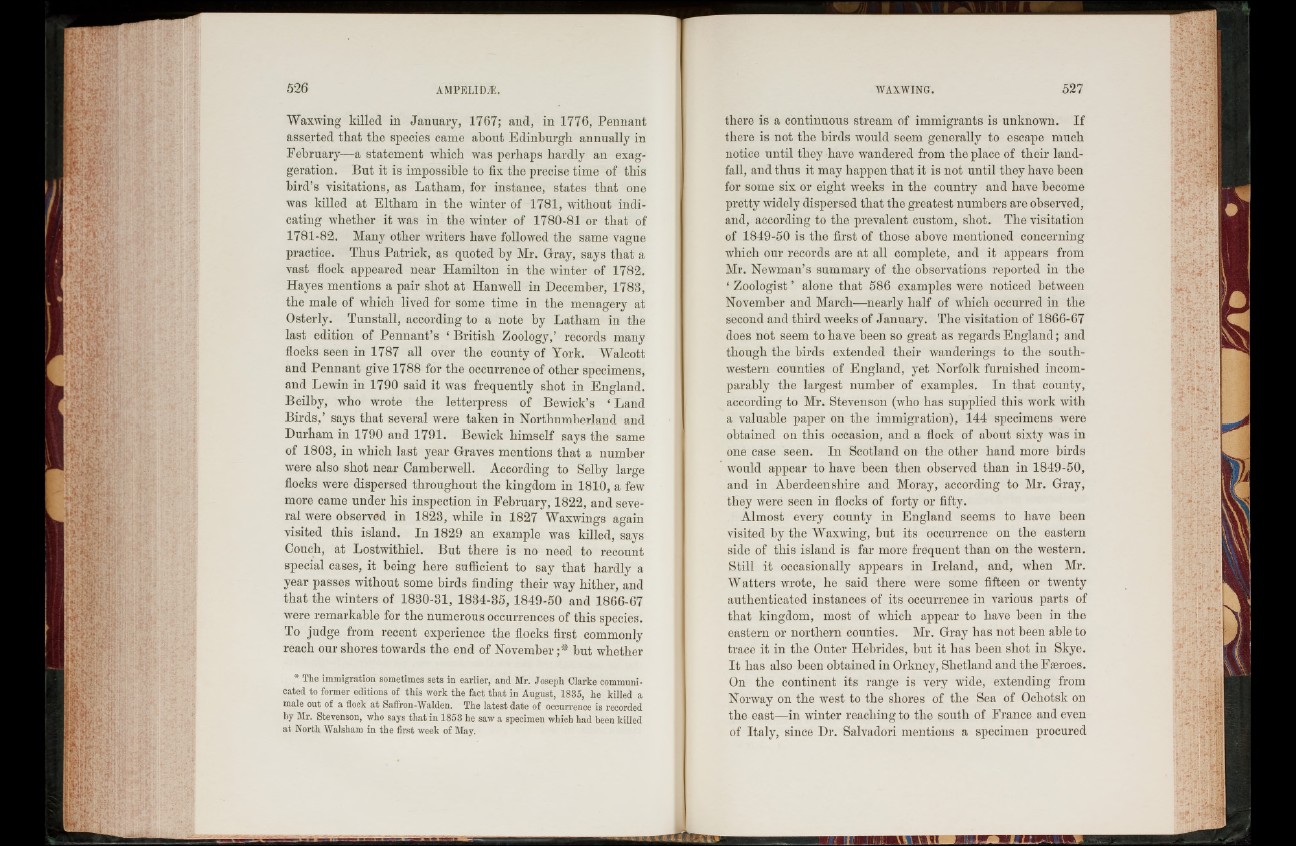
Waxwing killed in January, 1767; and, in 1776, Pennant
asserted that the species came about Edinburgh annually in
February—a statement which was perhaps hardly an exaggeration.
But it is impossible to fix the precise time of this
bird’s visitations, as Latham, for instance, states that one
was killed at Eltham in the winter of 1781, without indicating
whether it was in the winter of 1780-81 or that of
1781-82. Many other writers have followed the same vague
practice. Thus Patrick, as quoted by Mr. Gray, says that a
vast flock appeared near Hamilton in the winter of 1782.
Hayes mentions a pair shot at Hanwell in December, 1783,
the male of which lived for some time in the menagery at
Osterly. Tunstall, according to a note by Latham in the
last edition of Pennant’s ‘ British Zoology,’ records many
flocks seen in 1787 all over the county of York. Walcott
and Pennant give 1788 for the occurrence of other specimens,
and Lewin in 1790 said it was frequently shot in England.
Beilby, who wrote the letterpress of Bewick’s ‘ Land
Birds,’ says that several were taken in Northumberland and
Durham in 1790 and 1791. Bewick himself says the same
of 1803, in which last year Graves mentions that a number
were also shot near Camberwell. According to Selby large
flocks were dispersed throughout the kingdom in 1810, a few
more came under his inspection in February, 1822, and several
were observed in 1823, while in 1827 Waxwings again
visited this island. In 1829 an example was killed, says
Couch, at Lostwithiel. But there is no need to recount
special cases, it being here sufficient to say that hardly a
year passes without some birds finding their way hither, and
that the winters of 1830-31, 1834-35, 1849-50 and 1866-67
were remarkable for the numerous occurrences of this species.
To judge from recent experience the flocks first commonly
reach our shores towards the end of November ;* but whether
* The immigration sometimes sets in earlier, and Mr. Joseph Clarke communicated
to former editions of this work the fact that in August, 1835, he killed a
male out of a flock a t Saffron-Walden. The latest date of occurrence is recorded
by Mr. Stevenson, who says that in 1853 he saw a specimen which had been killed
at North Walsham in the first week of May.
there is a continuous stream of immigrants is unknown. If
there is not the birds would seem generally to escape much
notice until they have wandered from the place of their landfall,
and thus it may happen that it is not until they have been
for some six or eight weeks in the country and have become
pretty widely dispersed that the greatest numbers are observed,
and, according to the prevalent custom, shot. The visitation
of 1849-50 is the first of those above mentioned concerning
which our records are at all complete, and it appears from
Mr. Newman’s summary of the observations reported in the
‘ Zoologist ’ alone that 586 examples were noticed between
November and March—nearly half of which occurred in the
second and third weeks of January. The visitation of 1866-67
does not seem to have been so great as regards England; and
though the birds extended their wanderings to the southwestern
counties of England, yet Norfolk furnished incomparably
the largest number of examples. In that county,
according to Mr. Stevenson (who has supplied this work with
a valuable paper 011 the immigration), 144 specimens were
obtained on this occasion, and a flock of about sixty was in
one case seen. In Scotland on the other hand more birds
would appear to have been then observed than in 1849-50,
and in Aberdeenshire and Moray, according to Mr. Gray,
they were seen in flocks of forty or fifty.
Almost every county in England seems to have been
visited by the Waxwing, but its occurrence on the eastern
side of this island is far more frequent than on the western.
Still it occasionally appears in Ireland, and, when Mr.
Watters wrote, he said there were some fifteen or twenty
authenticated instances of its occurrence in various parts of
that kingdom, most of which appear to have been in the
eastern or northern counties. Mr. Gray has not been able to
trace it in the Outer Hebrides, but it has been shot in Skye.
I t has also been obtained in Orkney, Shetland and the Faeroes.
On the continent its range is very wide, extending from
Norway on the west to the shores of the Sea of Ochotsk on
the east—in winter reaching to the south of France and even
of Italy, since Dr. Salvadori mentions a specimen procured
—— mpw. mn w m w . » m u m m m